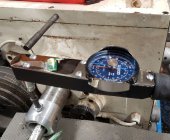If the barrel is in the 6-jaw with nothing else, and push up or down at the spider on the left side of the lathe, try to calculate max force with the spider to reach the stress at the end of barrel elasticity:
1) ignore shear force on long beam.
2) concentrate on bending moment:
a) assume tension on one side and compression on the other. Each are is 0.5 in squared centered 0.5" from the center. Assume the barrel sticks out of the chuck by 25". The stresses are then + 100X the spider force and - 100 times the spider force.
b) Stainless yields at ~ 60,000 psi. The max spider load on the cantilever is then 600 pounds.
When I push on the barrel muzzle with my thumb and move the test indicator on a breech spud, the force is ~~ 1 pound.
1) ignore shear force on long beam.
2) concentrate on bending moment:
a) assume tension on one side and compression on the other. Each are is 0.5 in squared centered 0.5" from the center. Assume the barrel sticks out of the chuck by 25". The stresses are then + 100X the spider force and - 100 times the spider force.
b) Stainless yields at ~ 60,000 psi. The max spider load on the cantilever is then 600 pounds.
When I push on the barrel muzzle with my thumb and move the test indicator on a breech spud, the force is ~~ 1 pound.













![dialing in barrel 20210305_202742_072[1].jpg](/data/attachments/298/298748-71d5ae79df583891118ac2f07aa08a7c.jpg?hash=cdWued9YOJ)

